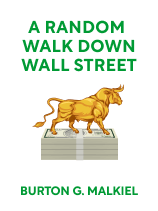

This article is an excerpt from the Shortform book guide to "A Random Walk Down Wall Street" by Burton G. Malkiel. Shortform has the world's best summaries and analyses of books you should be reading.
Like this article? Sign up for a free trial here .
What is behavioral investing? What behavioral traits can cause problems for investors?
Behavioral investing theories point out that people are generally not rational decision-makers. This is important for investing because a lot of people are actually irrational investors. Understanding (and avoiding) the common traits of an irrational investor will allow you to make better investment decisions.
Keep reading for more about behavioral investing.
Behavioral Investing and Irrational Investors
Analytical concepts like the efficient market hypothesis, modern portfolio theory, beta, and the capital-asset pricing model all rely on a foundational assumption: that each decision an investor makes is intended to maximize gain and minimize loss—that is, that each investor is fully rational.
A group of financial analysts influenced by behavioral psychologists like Daniel Kahneman and Amos Tversky has challenged this assumption, however, and in so doing has founded a new area of economic research: behavioral finance. (Shortform note: Read our summary of Kahneman’s Thinking Fast and Slow.)
For the reader looking for investment advice from the behavioral finance literature without the background, the key points are four:
1) Don’t Follow the Crowd
Studies in behavioral investing have shown that word of mouth is a frequent driver of stock purchases. When some new investment is the talk of the town, it’s natural to want to take part. But resist the urge: Stocks or funds that are hot one quarter are almost invariably losers the next. It’s generally better to stick with “value” stocks—securities issued by tried and true companies with steady revenues—than gamble on “growth” stocks with high risk.
The advice is the same for booms and busts in the market: If everyone’s getting out of the market in a slump, stay in (because, unless civilization ends, the market will rise again eventually); and if the market’s hot, stay out (because you’ll have bought high only to see the market drop, as it invariably will).
2) Don’t Overtrade
Overconfidence is one of the key factors in investor irrationality (see below), and it often manifests itself in hyperactive trading. (This is because an investor confident in her judgments will tend to buy and sell rapidly based on those judgments.) However, when investors trade to realize short-term gains, they tend to incur high transaction costs and taxes. One study of 66,000 households found that the households that traded the most earned an 11.4% return on their investments—while the market returned 17.9%.
As always, a buy-and-hold strategy is superior to trying to beat the market.
3) Sell Losers, Not Winners
If you do decide to trade, make sure you sell your losers, not your winners.
Most investors think it’s best to unload stocks that have risen in value (to realize a gain) and hold on to stocks that have declined in value (to avoid realizing a loss). As noted above, selling a winning stock can result in prohibitive tax liability.
And although holding on to a sinking stock can be worthwhile—if the stock has a chance to rebound—it’s often better to unload that stock and realize the tax breaks of the loss.
4) Don’t Fall for IPOs
Even the savviest investors are prone to falling for “get rich quick” schemes, and few are as prevalent and as pernicious as highly publicized initial public offerings.
Simply put, an individual investor should never buy an IPO at its initial price. Though the stock may pop right after trading begins—because institutional investors are snapping up the stock at the offering price—studies have shown that IPOs underperform the stock market by about 4% per annum. And it’s common to see IPO values drop exactly six months after going public—the date when insiders are finally allowed to unload their stock.
What Is Behavioral Investing?
Behavioral investing is an approach to financial markets and economic research that foregrounds human behavior. It proceeds from the premise that, contrary to most economic and financial models, people are not fully rational decision makers. In fact, research by Kahneman and Tversky has shown that people are irrational in systematic and predictable ways. According to Kahneman and Tversky, our irrationality stems from five key factors:
Factor #1: Overconfidence
One of the most consistent findings in behavioral psychology is that people tend to make mistakes of judgment because of an unjustified belief in their own knowledge or capacities.
The classic illustration of this cognitive bias comes from surveys that ask participants how they would rate their own driving ability. In studies focusing on college students, 80% to 90% said they were better drivers than their classmates. How, one might ask, can 90% of a population be above average?
This species of overconfidence affects investors as much as it does college students. In one experiment, Kahneman asked participants to provide an estimate of the Dow Jones’s value one month from the date of the experiment. He also asked the participants to pick a high number such that they were 99% sure the Dow would be below that number a month later, and a low number such that they were 99% sure the Dow would be above that number. The upshot of the estimates was that participants were 98% sure the Dow Jones’s value would fall in between the two numbers.
The results of the experiment showed that the investors, though they were 98% sure of their estimates, were wrong 20% of the time!
In actual market behavior, overconfidence manifests itself in a number of different ways:
- Beating the Market. Many investors, especially male investors, are confident they can beat the market, and so they trade far more frequently than they should. One study examining accounts at a discount brokerage found that the more frequently individual investors traded, the worse they did.
- Hindsight Bias. Investors are prone to attributing past successes to their own savvy and past failures to bad luck—when in fact both success and failure are largely the product of chance. Recognizing the role of luck in realizing returns is key to avoiding risk.
- Overvaluation of Growth. Investors’ overconfidence in their predictive powers leads to the general overvaluation of growth stocks. A hot new technology or app will often result in excessively optimistic growth projections—projections that frequently don’t pan out.
Factor #2: Judgment Biases
Much irrational investor behavior in the market stems from systematic cognitive biases that cloud humans’ judgment.
The Illusion of Control
One particularly problematic bias is our illusion of control: our perception that we can dictate events that are effectively random.
As noted above with regard to technical analysis (see Chapter 5), price movements in the market look more or less like the results of a coin flip or “random walk.” Yet investors persist in seeing patterns in these movements—for example, hot streaks or stock “momentum”—that cause them to make bad decisions.
The “Representativeness” Heuristic
Another judgment bias that can compromise our wealth is our tendency to substitute “representativeness” or “similarity” for cool, probabilistic analysis.
A classic example concerns skyrocketing prices for a buzzy new IPO. Although the data for much-touted IPOs show mixed results, investors will look at the new hyped stock and think “Amazon” or “Facebook”—that is, their judgment will be biased toward a “representative” case that may not reflect the reality at all.
Factor #3: Herding
As illustrated above by the tulip craze and dot-com bubble (see Chapter 2), the madness of crowds can wreak havoc in the markets. “Herding” (or “groupthink”) is the behavioral investing term for humans’ tendency to coalesce around a consensus judgment—even if that judgment is wrong.
One astounding study illustrates the point. In the experiment, social psychologists had a single person stand on a street corner and stare at the empty sky for exactly a minute to see how many people would stop and look also. Very few did. But when the researchers put five people on the corner, four times as many people stopped; when the researchers put 15 people on the corner, almost half of the people passing by stopped to look at the empty sky with them.
When word of mouth and media buzz tout a particular stock or industry, herd thinking can take hold, resulting in an onrush of investment and massively inflated prices. The psychologists refer to this phenomenon as the “epidemic” model—overexuberance about certain investments tends to spread like a disease.
Herd thinking can also lead to severe timing penalties. Because buzz spreads when stocks are up, investors will buy in when equities are already costly; when the prices of those equities fall, these investors are also the most likely to jump ship.
Factor #4: Loss Aversion
One of Kahneman and Tversky’s most influential discoveries is that humans mourn losses more than they relish gains. In other words, humans are naturally—and occasionally detrimentally—risk averse.
In one well-known experiment, Kahneman and Tversky offered participants a bet on a coin flip: If the coin came up heads, the subject would win $100; tails, and the subject would have to pay $100. Even though the odds of winning and losing were exactly the same—50/50—most declined to take the bet. Only when the possible winnings reached $250 (and losses reamined $100) did subjects agree to the bet. In other words, a dollar loss is 2.5x more undesirable than a dollar gain is desirable.
Associated with Kahneman and Tversky’s findings concerning loss aversion is their concept of “framing.” That is, humans’ loss aversion can increase or decrease depending on how a particular choice is worded or presented.
(Shortform example: Imagine two identical funds, Fund A and Fund B. Fund A’s prospectus describes the fund solely in terms of its risk profile and the losses it might incur; Fund B’s prospectus, on the contrary, describes the fund solely in terms of its potential returns. According to Kahneman and Tvesky’s research, even though the funds are identical, people will opt for Fund B because of how its risk is framed.)
Factor #5: Pride and Regret
The natural human dispositions of pride and regret can also cause problems for investors.
On the pride side, investors are often all too happy to advertise their successes, and there’s evidence to suggest that this pride in making a winning bet leads investors to make bad decisions—for example, selling a stock at a profit and incurring capital gains taxes (if the sale is made outside of a retirement account).
As far as regret goes, investors try to avoid it by holding onto losing stocks far longer than they should in the hope the stock will start rising. In a situation like this, it might actually be better to sell the stock and realize the tax deductions for the loss.
Irrationality and the Market
The core tenet of behavioral investing—that individual investors are frequently irrational—militates against the efficient market hypothesis, which states that stock prices reflect all relevant information about a particular stock. In many cases, according to the behavioralist, prices are completely divorced from the available information about a stock, due to irrational investor exuberance or decision-making.
Advocates of EMH respond to behavioralists by pointing up the correcting effects of “arbitrage”—which, in its loosest definition, means the purchase of undervalued stocks and sale of overvalued stocks (“buying low and selling high”). Believers in the EMH argue that professional portfolio managers will correct price distortions by (1) “shorting” overpriced stocks (“short selling” is when traders borrow securities and sell them, believing that the price of those securities will eventually go down and the trader can buy them back at a discount) and (2) investing in comparable stocks (so that if prices continue to rise, the managers will have offset their short positions by going “long” on similar stocks). When traders short stocks, demand tends to dry up and prices fall.
The main problem with this faith in arbitrage’s corrective power is arbitrage’s inherent riskiness—and, as a result, traders’ hesitancy to engage in it.
For example, say that a trader believes there’s going to be an oil shock in the next few months (and, as a result, a jump in oil prices). She might short car-manufacturer stocks (because, with gas prices high, people may buy fewer cars) and go long on petroleum company stocks. But what happens if the oil shock doesn’t come to pass? Or, even worse, petroleum companies find a new source of oil, driving gas prices down rather than up?
In fact, historical studies have shown that hedge funds, far from correcting prices with their positions, actually drive irrational exuberance in the market. The internet bubble of the late ’90s and early 2000s is a case in point.

———End of Preview———
Like what you just read? Read the rest of the world's best book summary and analysis of Burton G. Malkiel's "A Random Walk Down Wall Street" at Shortform .
Here's what you'll find in our full A Random Walk Down Wall Street summary :
- A comprehensive and entertaining introduction to the world of finance
- Practical investment principles that work for every skill level
- The advantages of index investing






